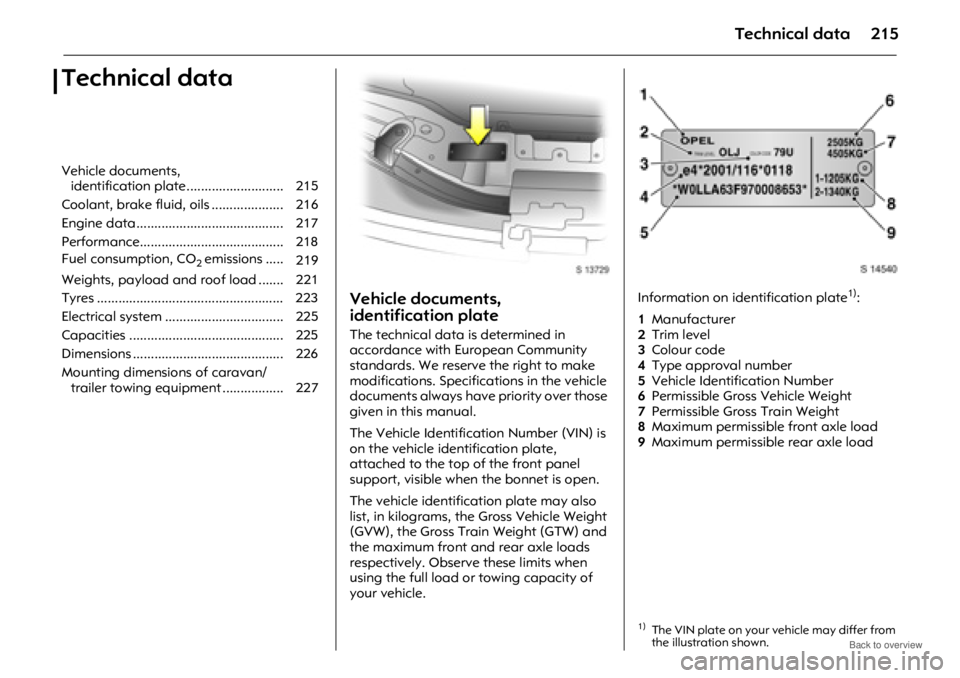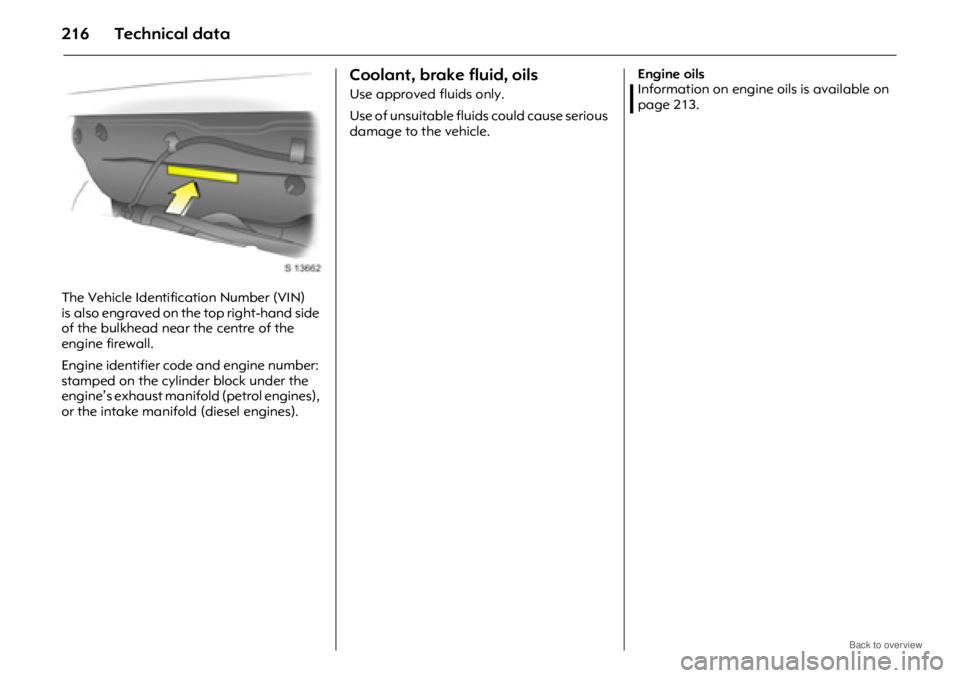OPEL ANTARA 2009 Owners Manual
Manufacturer: OPEL, Model Year: 2009, Model line: ANTARA, Model: OPEL ANTARA 2009Pages: 234, PDF Size: 3.01 MB
Page 211 of 234

Service, maintenance 211
International service schedule
(Antara Z 24 XE) Service operations by month 1)
km ( x 1000)1)
miles ( x 1000)1)
1)Whichever occurs first.
6
10
6.5 12
20
1318
30
2024
40
26.5 30
50
3336
60
40
Controls, lighting, signalling equi pment and airbags: visual check
steering lock and ignition lock: check xxx
Remote control batteries: replace Every 2 years
Windscreen wipers, windscreen washer system: check, correct xxx
Coolant level and antifreeze: check, correct
Hoses: check for tightness and secure seating xxx
Brake fluid level: check, correct xxx
Battery terminals: check for secu re connections and battery eye xxx
Vehicle system check with TECH2 xxx
Pollen filter: replace Annually/30 000 km/20 000 miles
oMore often for when dust, sand or pollen is in the air Agreement with customer
Air cleaner element: replace
Annually/30 000 km/20 000 miles
⊕Spark plugs and plug leads: replace Every 90 000 km/60 000 miles
Ribbed V-belt: visual check xxx
⊕Toothed belt and tension roller: visual check Annually/30 000 km/20 000 miles
Toothed belt and tension roller: replace Every 8 years/120 000 km/80 000 miles
Power steering system: check for leak s. Fluid level: check, correct xxx
Engine oil and oil filter: replace - fixed interval
2)
2)On vehicles with oil life monitoring, it may be necessary to change the engine oil earlier (control indicator illuminates).
xxxxxx
Page 212 of 234

212 Service, maintenance
Service operations by month 1)
km ( x 1000)1)
miles ( x 1000)1)
1)Whichever occurs first.
⊕ Additional operations.
o Under extreme operating conditions and if required by country-specific conditions, the intervals are reduced.
6
10
6.5 12
20
1318
30
2024
40
26.5 30
50
3336
60
40
Parking brake: check and adjust
Wheel mounting and suspension front an d rear, brake lines, brake pressure
hoses, fuel lines and exhaust system: visual check xxx
Corrosion protection: check and record in Service and Warranty Booklet Annually
Front and rear wheel br akes: check visually x x x
Engine, transmission, PTO, rear differential, A/C compressor: check for leaks xxx
Steering system boots, track rods , final drive: visual check xxx
Track rod end and supporting ball joint: check xxx
⊕Brake and clutch fluid: change Every 2 years
Wheel fastening: loosen and tighten to torque
Tyre condition and pressures: check, correct xxx
First aid kit, tyre repair kit and lash ing eyes: visual check Every 2 years
Headlamp aiming: check, adjust xxx
Door hinges, door stop, lock cylinder, lock striker, bonnet catch, tailgate
hinges and check links: lubricate xxx
Test drive, final check
Service interval display and oil life monitor: reset - if applicable xxx
Page 213 of 234

Service, maintenance213
Additional servicing
Additional operations ⊕
Additional work is work that is not required
every service but can be performed in
conjunction with a regular service.
Time allowances for such work are not
included in the scope of regular services
and will be charged for additionally. It is
more economic if these operations are
performed as part of a scheduled service
than having them performed separately.
Severe operating conditions o
Operating conditions are classified as
severe when one or more of the following
occurs frequently:
z cold starts,
z stop and go,
z trailer/caravan towing,
z gradients and/or high altitudes,
z poor road surfaces,
z sand and dust,
z extreme temperature fluctuations.
Police vehicles, taxis and driving school
vehicles are also cla ssified as operating
under severe conditions.
Under severe operating conditions, it may
be necessary to have certain scheduled
service work done more frequently than the
scheduled intervals.
For example, if fuel is used that does not
comply with required standards, the fuel
filter may need more frequent draining or
replacement and it may also be necessary
to change other components more often
(e.g. spark plugs). It is recommended to seek technical advice
on the servicing requirements dependent
on the specific operating conditions of your
vehicle.
Recommended fluids and
lubricants
Only use products that have been tested
and approved. Damage resulting from the
use of non-approved materials will not be
covered by the warranty.
Checking and topping up fluids
see page 191.
Engine oil
Engine oil is identified by its quality and
also its viscosity. Quality is more important
than viscosity when selecting which engine
oil to use.
Engine oil quality
European specifications
Opel engine oil m
eets classifications
GM-LL-A-025 and GM-LL-B-025 and is
therefore suitable for both petrol and
diesel engines.
International specifications
The above specification is valid only if the
service interval is reduced to that shown for
the international service schedule -
see pages 209 to 212.
Topping up engine oil
Oils of different manufacturers and brands
can be mixed as long as you comply with
the specified engine oil criteria (quality and
viscosity).
9 Warning
Operating materials are hazardous and
must be handled with the appropriate
level of care. If consumed, seek medical
attention immediatel y. Do not inhale
fumes and avoid skin contact. Keep out
of reach of children. Do not allow
operating materials to contaminate the
sewage system, surface water, ground
water or soil. Dispose of empty containers
properly. Always bear in mind that
operating materials are hazardous to
your health.
GM-LL-A-025: Petrol engines
GM-LL-B-025: Diesel engines without DPF
ACEA-C3 Diesel engines with DPF
GM General Motors Europe
LL Longlife
A or B Engine oil quality specification
025 Validity index
ACEA-A3: Petrol engines
ACEA-B4: Diesel engines without DPF
ACEA-C3: Diesel engines with DPF
Page 214 of 234

Service, maintenance214
Not every engine oil available on the
market meets the quality requirements,
always check the required specification
and rating is marked on the container.
If engine oil of the required quality is not
available, a maximum of 1 litre of ACEA
A3/B4 or A3/B3 grade may be used (only
once between each oil change). The
viscosity should be of the correct rating.
Use of ACEA A1/B1 and A5/B5 engine oil is
expressly forbidden, since they can cause
long-term engine damage under certain
operating conditions.
Engine oil additives
The use of engine oil additives could cause
damage and invalidate the warranty.
Engine oil viscosity
SAE 0W-30, 0W-40, 5W-30 or 5W-40 The SAE viscosity rating defines the ability
of an oil to flow. When cold, oil is more
viscous than when hot.
Multigrade oil is indicated by two figures.
The first figure, followed by a W, indicates
low temperature viscosity and the second
figure the high temperature viscosity.
Coolant and antifreeze
Use antifreeze of recommended
specification: silicate-free LLC (Long Life
Coolant).
The system is factory-filled with coolant
designed for frost protection down to
approx. -28 °C. This concentration should
be maintained all year-round.
Coolant additives intended to give
additional corrosion protection or seal
against minor leaks can cause function
problems. Liability for consequences
resulting from the use
of coolant additives
will be rejected.
Brake and clutch fluid
Only use DOT4 brake fluid.
Over time, brake fluid absorbs moisture
which will reduce braking effectiveness.
The brake fluid should therefore be
replaced at the specified interval.
Brake fluid should be stored in a sealed
container to avoid water absorption.
Ensure it does not become contaminated
with fluids containing mineral oil (oil,
petrol, cleaner) as this can damage the
seals and sleeves of the brake system.
9 Warning
Brake fluid is poisonous!
9 Warning
Due to its corrosive nature, it must not
come in contact with the paintwork. Flush
any escaped brake fluid with plenty of
water.
Page 215 of 234

Technical data215
Technical data
Vehicle documents,
identification plate
The technical data is determined in
accordance with European Community
standards. We reserve the right to make
modifications. Specifications in the vehicle
documents always have priority over those
given in this manual.
The Vehicle Identification Number (VIN) is
on the vehicle identification plate,
attached to the top of the front panel
support, visible when the bonnet is open.
The vehicle identification plate may also
list, in kilograms, the Gross Vehicle Weight
(GVW), the Gross Train Weight (GTW) and
the maximum front and rear axle loads
respectively. Observe these limits when
using the full load or towing capacity of
your vehicle. Information on identification plate
1):
1 Manufacturer
2 Trim level
3 Colour code
4 Type approval number
5 Vehicle Identifi cation Number
6 Permissible Gross Vehicle Weight
7 Permissible Gross Train Weight
8 Maximum permissible front axle load
9 Maximum permissible rear axle load
Vehicle documents,
identification plate........................... 215
Coolant, brake fluid, oils .................... 216
Engine data......................................... 217
Performance........................................ 218
Fuel consumption, CO
2emissions ..... 219
Weights, payload and roof load ....... 221
Tyres .................................................... 223
Electrical system ................................. 225
Capacities ........................................... 225
Dimensions .......................................... 226
Mounting dimensions of caravan/ trailer towing equipment ................. 227
1)The VIN plate on your ve hicle may differ from
the illustration shown.
Page 216 of 234

Technical data216
The Vehicle Identification Number (VIN)
is also engraved on the top right-hand side
of the bulkhead near the centre of the
engine firewall.
Engine identifier code and engine number:
stamped on the cylinder block under the
engine’s exhaust manifold (petrol engines),
or the intake manifold (diesel engines).
Coolant, brake fluid, oils
Use approved fluids only.
Use of unsuitable fluids could cause serious
damage to the vehicle.Engine oils
Information on engine oils is available on
page 213.
Page 217 of 234

Technical data 217
Engine data
Sales designation
Engine stamp
Engine identifier code 2.4 Petrol
Z 24 SE
Z 24 XE3.2 V6 Petrol
10 HM
Z 32 SE 2.0 Diesel
Z 20 S
Z 20 DMH2.0 Diesel
Z 20 S
Z 20 DM
Number of cylinders 4644
Bore dia. (mm) 87.589.0 83.083.0
Stroke (mm) 100.085.6 92.092.0
Piston displacement (cm
3) 2405 3195 1991 1991
Max. engine power (kW) at rpm 103
5200167
6600 110
400093
4000
Torque (Nm) at rpm 220
2400297
3200 320
2000295
2000
Compression ratio 9.6 10.3 17.5 17.5
Fuel type Petrol Petrol Diesel Diesel
Cetane requirement (CN) --49 (D)
1)
1)Standard high-quality fuels: D = Diesel.
49 (D)1)
Octane requirement (RON)2)
unleaded
or unleaded
2)Standard high-quality fuels, e.g. unleaded DIN EN 228; value printed in bold: recommended fuel.
913)4)
953)
3)Knock control system automatically adjusts ignition timing according to type of fuel used (octane number).4)Use of 91 RON fuel reduces power and torque. If no unleaded Premium fuel is available, 91 RON can be used, taking care to avoid high engine load
or full load as well as driving in mountainous terrain with a caravan/trailer load or high payload.
913)4)
953)-
- -
-
Max. permissible engine speed, continuous operation (rpm) approx. 6200 6700 4750
5)/45006)
5)Manual transmission.6)Automatic transmission.
4750
Engine oil consumption (l/1000 km) 0.60.60.60.6
Page 218 of 234

218 Technical data
Performance
(approx. km/h / mph)
Engine
1)
1)Sales designation - see page 217.
Z 24 XEZ 32 SEZ 20 DMH Z 20 DM
Maximum speed
2)
Manual transmission
Automatic transmission
2)The maximum speed indicated is achievable at kerb weight (without driver) plus 200 kg payload. Optional equipment could reduce the specified
maximum speed of the vehicle.
175/109
- -
203/126180/112
178/111174/108
-
Page 219 of 234

Technical data219
Fuel consumption, CO
2emissions
Directive 80/1268/EEC (last changed
by 2004/3/EG) has applied for the
measurement of fuel consumption
since 1996. The directive is oriented to actual driving
practices: Urban driving is rated at
approx.1/3 and extra-urban driving with
approx. 2/3 (urban and extra-urban
consumption). Cold starts and acceleration
phases are also taken into consideration.
The specification of CO
2 emission is also a
constituent of the directive. The figures given must not be taken as a
guarantee for the actual fuel consumption
of a particular vehicle.
All values are based on the EU base
model with standard equipment.
The calculation of fuel consumption as
specified by directive 2004/3/EG takes
account of the vehicle’s kerb weight,
ascertained in accordance with these
regulations. Optional extras may result
in slightly higher fuel consumption
and CO
2emission levels than those
quoted.
To convert l/100 km into mpg, divide 282
by number of litres/100 km.
Save fuel, protect the environment –
see page 129.
Page 220 of 234

220 Technical data
Fuel consumption
(approx. l/100 km), CO2 emission (approx. g/km)
Engine
1)
1)Sales designation – see page 217.
Z 24 XE Z 32 SEZ 20 DMH Z 20 DM
Manual transmission/Automatic transmission urban
extra-urban
total
CO
2
13.3/-
7.3/ -
9.6/ -
229/- - /16.4
- / 8.9
- /11.6
- /278 8.7/10.9
6.8/ 7.3
7.6/ 8.6
198/238 8.8/-
6.7/-
7.5/-
200/-